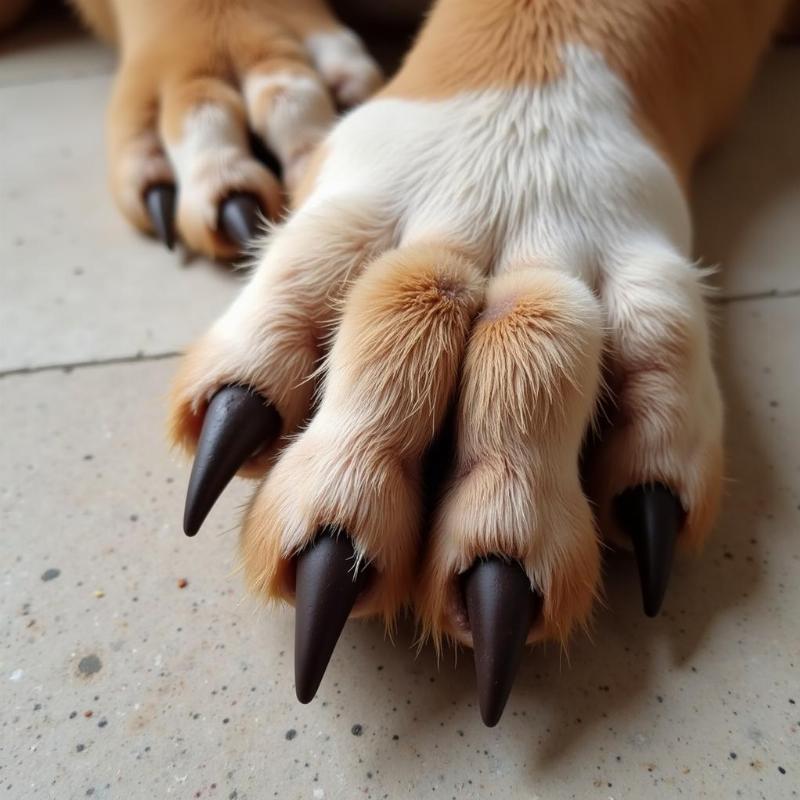The phrase “best corn dogs to buy” might conjure up images of a delicious treat at the state fair, but for dog owners, it takes on a different meaning. We’re not talking about the deep-fried kind; we’re discussing corns, calluses, and other paw pad issues that can plague our furry friends. Finding the right products to treat and prevent these problems is crucial for ensuring your dog’s comfort and well-being. This guide will explore the best approaches to buying products for corn, callus, and paw pad care for your canine companion.
Paw pads are a dog’s first line of defense against the harsh elements, from hot pavement to icy sidewalks. Just like our own skin, they can become dry, cracked, and even develop painful corns and calluses. Identifying the right products to soothe and protect these vulnerable paw pads is an essential part of responsible dog ownership. This involves understanding the causes of these issues, knowing what to look for in effective treatments, and choosing products specifically designed for canine use.
Understanding Corn and Callus Formation in Dogs
Corns and calluses on a dog’s paw pads are thickened areas of skin that develop as a protective response to repeated friction or pressure. They often appear as raised, circular bumps, and while they may not always cause pain, they can become uncomfortable, especially if left untreated. Several factors contribute to their formation, including:
- Excessive activity: Frequent running or walking on hard surfaces can increase friction on the paw pads, leading to callus development.
- Abnormal gait: Dogs with gait abnormalities may place uneven pressure on their paws, increasing the risk of corns and calluses in specific areas.
- Obesity: Excess weight puts added strain on the paw pads, making them more susceptible to these issues.
- Age: Older dogs are more prone to developing calluses due to the natural thinning of the paw pad skin.
 Chân chó bị chai
Chân chó bị chai
Choosing the Right Products: Balms, Pads, and Boots
Protecting and treating your dog’s paw pads requires a multi-faceted approach. Fortunately, a variety of products are available to help. Here’s a breakdown of the most common and effective options:
- Paw balms: These moisturizing balms are designed to soothe and hydrate dry, cracked paw pads. Look for balms containing natural ingredients like shea butter, beeswax, and coconut oil. Avoid products with artificial fragrances or colors.
- Protective pads: These adhesive pads provide a cushioning layer between your dog’s paws and the ground, reducing friction and protecting against further irritation. They are particularly useful for dogs with existing corns or calluses.
- Dog boots: While not a treatment per se, boots offer excellent protection against the elements, especially during hot summer months or on icy winter walks. They can prevent further irritation and allow existing corns and calluses to heal.
Preventative Measures: Keeping Those Paws Healthy
While treating existing corns and calluses is important, prevention is always the best approach. Here are some tips to keep your dog’s paw pads healthy:
- Regular paw checks: Inspect your dog’s paws regularly for any signs of dryness, cracks, or abnormalities.
- Maintain a healthy weight: Keeping your dog at a healthy weight reduces stress on their joints and paw pads.
- Trim nails regularly: Long nails can alter a dog’s gait and increase pressure on the paw pads.
- Provide soft resting areas: Offer your dog comfortable bedding and avoid forcing them to stand or walk on hard surfaces for extended periods.
Conclusion: Prioritizing Paw Pad Health
Taking care of your dog’s paw pads is a critical aspect of responsible pet ownership. By understanding the causes of corns and calluses and choosing the right products, you can help your furry friend stay comfortable and active. Remember, regular paw checks and preventative measures are key to ensuring your dog’s overall well-being. Don’t let paw pad problems slow your dog down; with the right care, those paws can keep pounding the pavement for years to come.
FAQ
- What are the signs of a corn on a dog’s paw pad? A corn usually appears as a small, raised, circular bump on the paw pad. It may be painful to the touch.
- Can I use human foot cream on my dog’s paws? It’s best to use products specifically formulated for dogs, as some human products can contain ingredients that are harmful to pets.
- How often should I apply paw balm? Follow the instructions on the product label, but generally, applying balm 2-3 times a week or as needed is sufficient.
- Are dog boots necessary for all dogs? Not all dogs require boots, but they can be beneficial for protecting paws from extreme temperatures, rough terrain, and irritating substances.
- How can I tell if my dog’s corn is infected? Signs of infection include redness, swelling, pus, and a foul odor. Consult a veterinarian if you suspect an infection.
- What should I do if my dog’s corn doesn’t improve with home treatment? If the corn persists or worsens, it’s important to consult a veterinarian for professional advice and treatment.
- Can corns on a dog’s paw pads be surgically removed? In rare cases, surgical removal may be necessary, but this is typically a last resort.
Beautdogs.us is your trusted source for comprehensive and engaging information on dog care and companionship in the USA. We offer expert advice on everything from breed-specific needs to choosing the right products for your furry friend. As a leading authority on dog lifestyles in America, we’re committed to providing valuable resources for both new and experienced dog owners. Contact us for all your dog-related questions! Email: [email protected], Phone: +1 501-555-7529. Visit Beautdogs.us for more expert tips and advice on dog care.